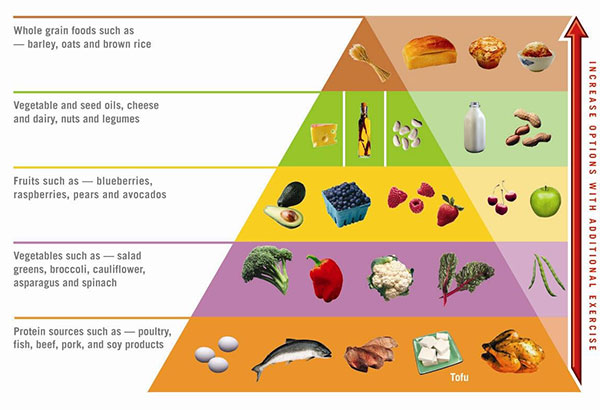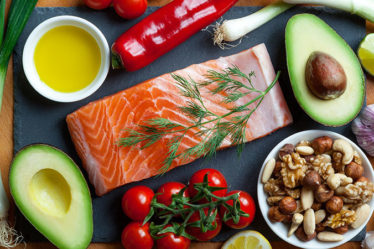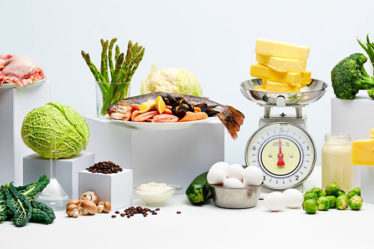
The Atkins Diet is a counterintuitive weight loss plan that, on its introduction in the 1960s, flipped the accepted idea of how to lose weight on its head. Rather than the eating plan advocated by other weight-loss programs, which were based on reduction or removal of fatty foods, the Atkins diet increases intake of high-fat and protein-rich foods, while restricting consumption of foods high in carbs. The simple premise of the Atkins dietary plan is that by limiting intake of carbs, your body is deprived of its usual source of fuel and will be forced to turn to its reserves of fat for energy, thereby prompting weight loss.
Dr. Robert C. Atkins, a cardiologist, believed that obesity and its related conditions; heart disease and Type 2 diabetes, resulted from a diet that was low in fats and high in carbs – the typical American diet. He held that excessive indulgence in sugar and refined carbs led to blood-sugar imbalance, obesity and cardiovascular diseases. The Atkins diet is built around the control of carbs versus the avoidance of meat and excess fat. The plan does not simply aim to reduce total carbs consumption; it seeks to limit the amount of carbs a person takes in at a time or restrict their Net Carbs intake.
Net carbs as defined by the Atkins website is ‘grams of carbs minus grams of fiber and grams of sugar alcohols.’ By limiting the body’s sources of carbs to mainly vegetables, the plan maintains intake of carbs at between 20 to 40 grams a day, depending on the person’s weight-loss goals. As the targeted weight is approached, the person begins to add select carbs back into their diet until the ideal weight is achieved. After which, that weight is maintained by continuing the diet.
Atkins Dietary Plan Structure
The Atkins Nutritional Approach uses a four-phased plan with two versions;
- Version 1, also called Atkins 20, is for people who have a waist measurement of over 35 inches for women or 40 inches for men and want to lose more than 40 lb. it is also recommended if a person has Type 2 diabetes. It is called Atkins 20 because in the first phase, daily carbs consumption is limited to 20 grams.
- Version 2 or Atkins 40 is for people who want to lose less than 40 lb or those who require a diet with greater variety, such as pregnant women or nursing mothers. Atkins 40 limits daily carbs intake to 40 grams.
The four phases of the Atkins diet apply with both versions. The phases are:
- Induction: The person eats a high-fat, protein-rich diet, with low-carb vegetables to initiate weight loss. Induction lasts anywhere from two weeks to many months.
- Balancing: Participants may slowly add nuts, more low-carb vegetables and some fruit to their diet until they know how many carbs they can eat and still maintain weight-loss
- Fine-Tuning: At the stage where they are ten pounds away from their target weight, the person adds more carbs to their diet to slow down weight loss.
- Maintenance: They may now eat as many healthy carbs as they can without regaining weight.
Pros and Cons of the Atkins Diet
Pros
- Easy To Follow
The diet has a simple structure that is straightforward and easy to follow. And since focus is on a few food groups and there is no need to measure portions, it makes it easier to stick with. - No Feelings of Deprivation
The feeling of being deprived, the tendency to binge on forbidden foods and the guilt of not following a diet plan are all eliminated. The person can limit carbs and still have many tasty meal options. - Eliminates Persistent Hunger
Since the diet is based on a protein-rich, high fats diet, the person does not feel hungry perpetually because fats and protein keep them feeling fuller for longer. - Flexibility
The Atkins diet does not require calorie counting or portion control. By using a system that tracks net carbs consumption, it offers a lot more flexibility - No Exercise Required
Working out is not required for weight-loss on the Atkins dietary plan. Although recommended, it is not obligatory. - Improved Overall Health
Studies have shown that low-carbs diets such as Atkins result in reduced levels of triglyceride and better heart health, as well as Increased levels of HDL or good cholesterol.
Cons
- Dietary Imbalance
By eliminating a whole food group from the diet, the person may not be getting a well-balanced diet and will be deprived of some essential nutrients. - Negative Side-Effects
The Atkins Diet drastic cut in carbs may cause some people to experience headaches, dizziness, weakness, fatigue and constipation. Carbs restrictions often result in a diet with insufficient fiber. - Dehydration
Carbs hold water in the body. Elimination or excessive restriction of carbs intake could lead to dehydration. Although a person may lose weight in the initial phase of the Atkins dietary plan, that loss could be water weight, which may lead to chemical imbalances that overwork some body organs. - Costly
An Atkins is expensive to maintain because food has to be eaten fresh and must be non-processed. Adherents might experience more than a doubling of their weekly spend on food.
Who Is This Eating Plan For?
This plan is suitable for persons who:
- Have a weight problem, yet struggle with maintaining a diet that is based on counting calories.
- Are happy with preparing their meals from scratch
- Hate exercise but still want to lose weight
- Want to have the benefits of eating tasty meals, while losing weight
- Do not have severe kidney disease and are not taking diuretics, insulin or oral diabetes.
Sports And The Atkins Diet Plan
Some athletes opt for a low-carbs diet like Atkins because studies have shown that a low-carbs helps the body to burn fat rather than store it. If a person participates in the following categories of sports, either professionally or as a lifestyle choice, they will find the Atkins diet beneficial:
- Endurance sports: e.g. cycling and distance running
- Resistance Training
Foods Permitted and Not Permitted In An Atkins Diet
Permitted
- Meats; Fatty fish and seafood; Eggs; Low-carb vegetables; Full-fat dairy; Nuts and seeds, and Healthy fats.
Not Permitted
- Sugar; Grains; Vegetable oils; Trans fats; High-carb vegetables; High-carb fruits; Starches, and Legumes
Scientific Basis For This Diet
Numerous studies by The Harvard School of Public Health show the effectiveness of low-carb diets in helping people lose quicker and more sustainably than a low-fat diet does. The studies also show that people using a low-carbs diet had better overall level of heart health.
In October 2012 the American Journal of Epidemiology published a study involving 2,500 participants where researchers found that participants on a low-carb diet outperformed those on a low-fat diet significantly in the reduction of total cholesterol and triglyceride levels.



